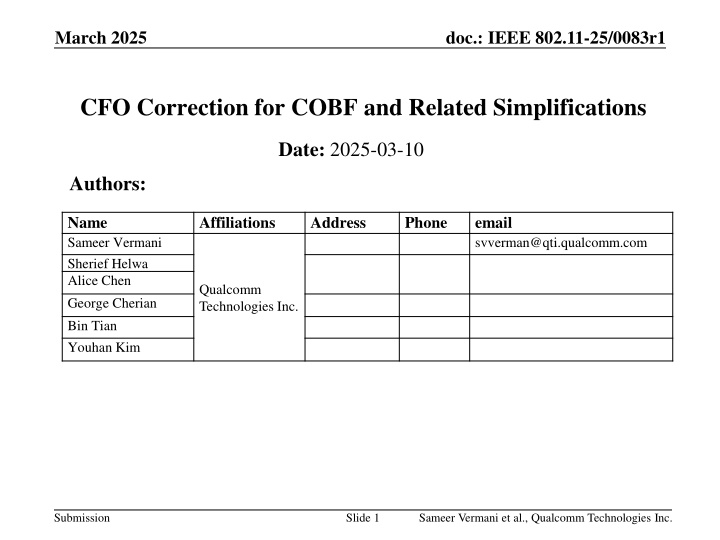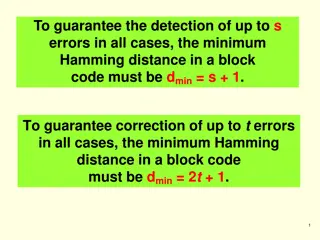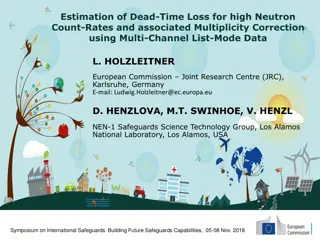
IEEE 802.11-25/0083r1: CFO Correction for COBF and Related Simplifications
Explore the proposal for CFO correction schemes for COBF in IEEE 802.11bn, focusing on Sync-reference and Sync-follower concepts, general principles for transmission stage pre-corrections, and simplifications to make the protocol agnostic to different scenarios.
Download Presentation

Please find below an Image/Link to download the presentation.
The content on the website is provided AS IS for your information and personal use only. It may not be sold, licensed, or shared on other websites without obtaining consent from the author. If you encounter any issues during the download, it is possible that the publisher has removed the file from their server.
You are allowed to download the files provided on this website for personal or commercial use, subject to the condition that they are used lawfully. All files are the property of their respective owners.
The content on the website is provided AS IS for your information and personal use only. It may not be sold, licensed, or shared on other websites without obtaining consent from the author.
E N D
Presentation Transcript
March 2025 doc.: IEEE 802.11-25/0083r1 CFO Correction for COBF and Related Simplifications Date: 2025-03-10 Authors: Name Sameer Vermani Sherief Helwa Alice Chen George Cherian Bin Tian Youhan Kim Affiliations Address Phone email svverman@qti.qualcomm.com Qualcomm Technologies Inc. Submission Slide 1 Sameer Vermani et al., Qualcomm Technologies Inc.
March 2025 doc.: IEEE 802.11-25/0083r1 Introduction CFO correction for COBF is an open topic in 802.11bn In this document we propose CFO correction schemes for COBF Outline Sync-reference and Sync-follower Sounding stage CFO correction General principles for transmission stage pre-corrections Two cases for transmission stage Sync-reference as TxOP owner or sharing AP Sync-follower as TxOP owner or sharing AP Simplifications to make the protocol agnostic to the above two possibilities Summary Submission Slide 2 Sameer Vermani et al., Qualcomm Technologies Inc.
March 2025 doc.: IEEE 802.11-25/0083r1 Sync-reference and Sync-Follower We introduce the concept of Sync-reference and Sync-Follower APs They are defined as follows: Sync-reference AP: The AP acting as a frequency reference during sounding stage and beyond Does not need to remember CFO re-corrections Sync-Follower AP: The AP that aligns its frequency with respect to the Sync-reference AP during sounding stage and beyond Remembers pre-corrections How to decide which AP gets to be the sync-reference is out of the scope of this presentation Submission Slide 3 Sameer Vermani et al., Qualcomm Technologies Inc.
March 2025 doc.: IEEE 802.11-25/0083r1 Sounding stage CFO correction Sync-Follower AP can estimate CFO from that NDPA frame and pre-compensate for it in its future NDP transmissions when doing cross-BSS sounding Note, we propose only cross-BSS NDP pre-correction as a mandatory requirement The in-BSS NDP of follower AP is recommended to be pre-corrected (but not mandatory) Since the pre-correction only impacts performance of STAs in that BSS, and there might be other ways to perform post- correction of in-BSS channel estimates to avoid performance loss, we refrain from mandating this Same idea applies for joint sounding Measurement Phase SIFS SIFS SIFS SIFS AP1 NDPA NDP NDPA NDP BFRP BFRP STA1 CSI CSI SIFS SIFS SIFS SIFS SIFS SIFS SIFS SIFS SIFS SIFS SIFS AP2 NDPA NDP NDPA NDP BFRP BFRP STA2 CSI CSI Sync-Follower AP (AP2) estimates CFO w.r.t. Sync- Reference AP Sync-Follower AP pre-compensates CFO before Tx Sequential Sounding Submission Slide 4 Sameer Vermani et al., Qualcomm Technologies Inc.
March 2025 doc.: IEEE 802.11-25/0083r1 General principles for transmission stage Want to keep transmission stage protocol as consistent as possible regardless of which AP is sync reference The sharing AP is the AP that transmits the final sync frame Regardless of who is the sync-reference and sync-follower Consistent behavior for sharing AP Additionally, we propose that the shared AP always pre-corrects COBF PPDU based on the final sync To bring the two APs within a small frequency range of each other (e.g. ~350Hz) Regardless of who is the sync-reference, consistent behavior at shared AP Also need the sounding stage frequencies be carried over to the transmission stage When the sync follower is the sharing AP, it uses the same pre-correction values as sounding stage to send the COBF sync and the COBF PPDU Note that the carrier frequencies at both APs may drift in the time elapsed since sounding But this drift does not impact the performance even if it is up-to a few kHz Submission Slide 5 Sameer Vermani et al., Qualcomm Technologies Inc.
March 2025 doc.: IEEE 802.11-25/0083r1 Transmission stage CFO correction: Sharing AP is the Sync reference For the transmission phase, if the TXOP owner (sharing AP) is the Sync-reference AP, the Sync-Follower AP can align its frequency based on CFO estimate from the CoBF Sync frame Shared TXOP Sync-reference AP AP1 SIFS SIFS CoBF Invite CoBF Sync Sync-reference AP is TXOP owner Sharing AP DL PPDU STA1 BA SIFS Sync-Follower AP SIFS CoBF Response Shared AP AP2 DL PPDU STA2 Sync-Follower AP (AP2) estimates CFO w.r.t. Sync- reference AP BA Sync-Follower AP pre- compensates CFO before Tx Submission Slide 6 Sameer Vermani et al., Qualcomm Technologies Inc.
March 2025 doc.: IEEE 802.11-25/0083r1 Transmission stage CFO correction: Sharing AP is the Sync Follower Sharing AP still transmits the COBF Sync frame COBF Sync and DL PPDU needs to be close in frequency to the sounding stage frequency of AP1 Can be easily achieved through remembering the sounding stage pre-correction Shared AP still aligns its frequency based on CFO estimate from the COBF Sync frame No change in behavior at a shared AP in response to a COBF sync Transmitted with same pre-correction as sounding phase Shared TXOP Sync-Follower AP AP1 SIFS SIFS CoBF Invite CoBF Sync Sharing AP Sync-follower AP is DL PPDU STA1 BA TXOP owner SIFS Sync-reference AP SIFS CoBF Response Shared AP AP2 DL PPDU STA2 BA Shared AP (AP2) estimates CFO w.r.t. sharing AP Shared AP pre- compensates CFO before Tx Submission Slide 7 Sameer Vermani et al., Qualcomm Technologies Inc.
March 2025 doc.: IEEE 802.11-25/0083r1 Summary Define the concept of Sync-reference and Sync-Follower Sync follower remembers frequency offset to the reference that is needed for pre- correction, during the sounding stage and the transmission stage Proposed solution Sync follower AP corrects its NDP transmissions during the sounding stage Correction of cross-BSS NDPs is mandatory Sharing AP transmits the final COBF sync for the COBF PPDU Shared AP always pre-corrects based on the final COBF sync from the sharing AP When the sync follower is the sharing AP, it uses the same pre-correction values as sounding stage to send the COBF sync and the COBF PPDU Submission Slide 8 Sameer Vermani et al., Qualcomm Technologies Inc.
March 2025 doc.: IEEE 802.11-25/0083r1 SP1 Do you support defining the concept of a sync-reference AP and a sync-follower AP for CFO corrections in COBF? Sync-follower AP pre-corrections needed For sequential sounding: All the NDPs sent by it during sounding phase that are sent for the purpose of sounding the STAs in the other BSS (Mandatory) For the NDPs sent by it for sounding the STAs in its own BSS, it is recommended but not mandatory that the sync follower AP pre-correct those NDPs For joint sounding: All the NDPs sent by it during the sounding phase The COBF sync and COBF PPDU during transmission phase using the same frequency pre-correction value as the sounding phase, when it is the sharing AP Sync-reference AP does not pre-correct during transmission phase when it is the sharing AP Submission Slide 9 Sameer Vermani et al., Qualcomm Technologies Inc.
March 2025 doc.: IEEE 802.11-25/0083r1 SP2 Do you support that in the sounding phase of COBF, the sync-follower AP shall use the NDPA frame sent by the sync-reference AP to pre- correct the NDP frequency to be within a TBD range (e.g., 350Hz) of the sync-reference AP s frequency? Applies to sequential and joint sounding The pre-correction of cross-BSS NDP and joint NDP is mandatory The pre-correction of in-BSS NDPs is recommended but not a mandatory requirement Submission Slide 10 Sameer Vermani et al., Qualcomm Technologies Inc.
March 2025 doc.: IEEE 802.11-25/0083r1 SP3 Do you support that in the COBF transmission phase, the sharing AP is the AP that transmits the final sync frame before the COBF PPDU Regardless of who is the sync-reference Note: This ensures a consistent protocol and a consistent behavior at sharing AP Submission Slide 11 Sameer Vermani et al., Qualcomm Technologies Inc.
March 2025 doc.: IEEE 802.11-25/0083r1 SP4 Do you support that in the COBF transmission phase, the shared AP always pre-corrects COBF PPDU based on the final sync To bring the two APs within a TBD frequency range of each other (e.g., ~350Hz) Note: Regardless of which AP is the sync-reference, this ensures consistent behavior at shared AP Submission Slide 12 Sameer Vermani et al., Qualcomm Technologies Inc.
March 2025 doc.: IEEE 802.11-25/0083r1 Protocols for joint and sequential sounding APPENDIX Submission Slide 13 Sameer Vermani et al., Qualcomm Technologies Inc.
March 2025 doc.: IEEE 802.11-25/0083r1 Joint Sounding protocol needs CFO Pre- correction of NDP frames Sounding happens one BSS at a time Below shows the 2 AP, 1STA per AP case NDP BF RP NDPA NDP Sharing AP1 NDPA BF RP NDP NDP Shared AP2 This frame is transmitted at the same pre-correction as previous NDP STA1 associated with AP1 Needs precorrection to bring within 350 Hz Large V based feedback STA2 associated with AP2 Large V based feedback Submission Slide 14 Sameer Vermani et al., Qualcomm Technologies Inc.
March 2025 doc.: IEEE 802.11-25/0083r1 Sequential Sounding CFO Issues Sounding happens one BSS at a time (shown by BRCM[1]) Below shows the 2 AP, 1STA per AP case Phase 1 sounds STA1 in BSS1 and phase 2 sounds STA2 in BSS2 Phase 1 Phase 2 Sharing AP1 NDP BF RP NDPA BF RP NDPA NDP BF RP BF RP NDPA NDP NDPA NDP Shared AP2 STA1 associated with AP1 CSI CSI STA2 associated with AP2 CSI CSI If the two APs just transmit NDPs at their frequency, the feedback tones at the two APs may differ by up-to 40ppm During actual transmission stage, we will have to make shared AP synchronize to sharing AP for the joint LTF phase Ran sims to evaluate performance impact of precoding tones being different than transmission tones Submission Slide 15 Sameer Vermani et al., Qualcomm Technologies Inc.
March 2025 doc.: IEEE 802.11-25/0083r1 Possible solution for the sequential sounding CFO Issues Phase 2 Phase 1 Sharing AP1 NDP BF RP NDPA BF RP NDPA NDP CFO Precorrection BF RP BF RP NDPA NDP NDPA NDP Shared AP2 CFO Precorrection STA1 associated with AP1 CSI CSI STA2 associated with AP2 CSI CSI All NDP frames are synced to sharing AP (transmitter of the first NDPA) First yellow NDP needs to perform pre-correction to sync to the green NDPA before it Second yellow NDP needs to use the same pre-correction as the one during first yellow NDP Shared AP needs to remember the correction from the phase 1, to use it during the second phase when it is the transmitter of the NDP Slide 16 Submission Sameer Vermani et al., Qualcomm Technologies Inc.






















